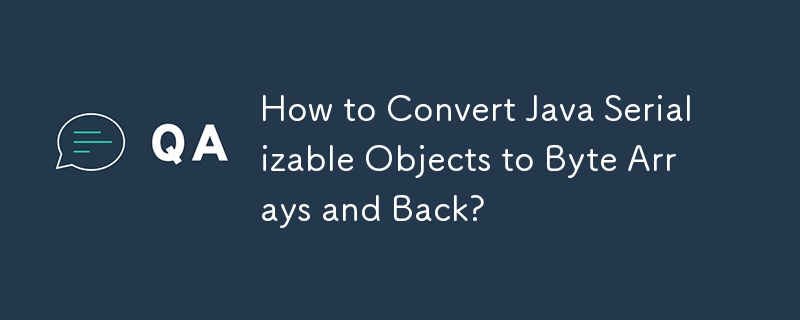How to Convert Java Serializable Objects to Byte Arrays and Back?

Converting Java Serializable Objects to Byte Arrays
In situations where you need to transmit Java objects across a network or store them in a binary format, converting them to byte arrays can be essential. Let's consider a scenario where we have a serializable class AppMessage. To send AppMessage instances over sockets to another machine and reconstruct them from the received bytes, we can follow these steps:
Serialization: Converting an Object to a Byte Array
- Prepare the ByteArrayOutputStream: Create a ByteArrayOutputStream to serve as a temporary storage for the serialized object.
- ObjectOutputStream: Use an ObjectOutputStream to write the object into the ByteArrayOutputStream.
- Flush and Read Bytes: Flush the ObjectOutputStream to ensure all data is written to the byte buffer and retrieve the byte array from ByteArrayOutputStream.
The code snippet for this process:
static byte[] serialize(final Object obj) {
ByteArrayOutputStream bos = new ByteArrayOutputStream();
try (ObjectOutputStream out = new ObjectOutputStream(bos)) {
out.writeObject(obj);
out.flush();
return bos.toByteArray();
} catch (Exception ex) {
throw new RuntimeException(ex);
}
}Deserialization: Reconstructing an Object from a Byte Array
- Create a ByteArrayInputStream: Convert the byte array back into an input stream using ByteArrayInputStream.
- ObjectInputStream: Create an ObjectInputStream from ByteArrayInputStream to read the object data.
- readObject(): Use the readObject() method to reconstruct the original object from the byte stream.
The corresponding code snippet:
static Object deserialize(byte[] bytes) {
ByteArrayInputStream bis = new ByteArrayInputStream(bytes);
try (ObjectInput in = new ObjectInputStream(bis)) {
return in.readObject();
} catch (Exception ex) {
throw new RuntimeException(ex);
}
}With these methods in place, you can efficiently send serializable objects, such as AppMessage instances, over networks and reconstruct them on the receiving end.
The above is the detailed content of How to Convert Java Serializable Objects to Byte Arrays and Back?. For more information, please follow other related articles on the PHP Chinese website!

Hot AI Tools

Undresser.AI Undress
AI-powered app for creating realistic nude photos

AI Clothes Remover
Online AI tool for removing clothes from photos.

Undress AI Tool
Undress images for free

Clothoff.io
AI clothes remover

Video Face Swap
Swap faces in any video effortlessly with our completely free AI face swap tool!

Hot Article

Hot Tools

Notepad++7.3.1
Easy-to-use and free code editor

SublimeText3 Chinese version
Chinese version, very easy to use

Zend Studio 13.0.1
Powerful PHP integrated development environment

Dreamweaver CS6
Visual web development tools

SublimeText3 Mac version
God-level code editing software (SublimeText3)

Hot Topics
 Is the company's security software causing the application to fail to run? How to troubleshoot and solve it?
Apr 19, 2025 pm 04:51 PM
Is the company's security software causing the application to fail to run? How to troubleshoot and solve it?
Apr 19, 2025 pm 04:51 PM
Troubleshooting and solutions to the company's security software that causes some applications to not function properly. Many companies will deploy security software in order to ensure internal network security. ...
 How to simplify field mapping issues in system docking using MapStruct?
Apr 19, 2025 pm 06:21 PM
How to simplify field mapping issues in system docking using MapStruct?
Apr 19, 2025 pm 06:21 PM
Field mapping processing in system docking often encounters a difficult problem when performing system docking: how to effectively map the interface fields of system A...
 How to elegantly obtain entity class variable names to build database query conditions?
Apr 19, 2025 pm 11:42 PM
How to elegantly obtain entity class variable names to build database query conditions?
Apr 19, 2025 pm 11:42 PM
When using MyBatis-Plus or other ORM frameworks for database operations, it is often necessary to construct query conditions based on the attribute name of the entity class. If you manually every time...
 How do I convert names to numbers to implement sorting and maintain consistency in groups?
Apr 19, 2025 pm 11:30 PM
How do I convert names to numbers to implement sorting and maintain consistency in groups?
Apr 19, 2025 pm 11:30 PM
Solutions to convert names to numbers to implement sorting In many application scenarios, users may need to sort in groups, especially in one...
 How does IntelliJ IDEA identify the port number of a Spring Boot project without outputting a log?
Apr 19, 2025 pm 11:45 PM
How does IntelliJ IDEA identify the port number of a Spring Boot project without outputting a log?
Apr 19, 2025 pm 11:45 PM
Start Spring using IntelliJIDEAUltimate version...
 E-commerce platform SKU and SPU database design: How to take into account both user-defined attributes and attributeless products?
Apr 19, 2025 pm 11:27 PM
E-commerce platform SKU and SPU database design: How to take into account both user-defined attributes and attributeless products?
Apr 19, 2025 pm 11:27 PM
Detailed explanation of the design of SKU and SPU tables on e-commerce platforms This article will discuss the database design issues of SKU and SPU in e-commerce platforms, especially how to deal with user-defined sales...
 How to safely convert Java objects to arrays?
Apr 19, 2025 pm 11:33 PM
How to safely convert Java objects to arrays?
Apr 19, 2025 pm 11:33 PM
Conversion of Java Objects and Arrays: In-depth discussion of the risks and correct methods of cast type conversion Many Java beginners will encounter the conversion of an object into an array...
 How to elegantly get entity class variable name building query conditions when using TKMyBatis for database query?
Apr 19, 2025 pm 09:51 PM
How to elegantly get entity class variable name building query conditions when using TKMyBatis for database query?
Apr 19, 2025 pm 09:51 PM
When using TKMyBatis for database queries, how to gracefully get entity class variable names to build query conditions is a common problem. This article will pin...






